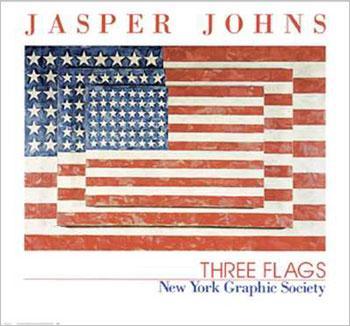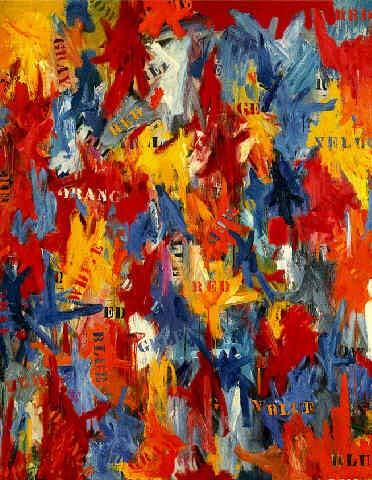Art History Study Guide.
Image IDs
Jasper John: Three Flags. Encaustic- wax and pigment mix.

"target," Jasper Johns.

"Painted Bronze." John Jasper. Cast Bronze trying to look like found Objects.

jasper johns false start

Rauchengery and Johns: Neo Dada. Use of found objects and highly conceptual. Sites People from history.
"How to Explain Pictures to A Dead Hare," Joseph Beuys. Action.

Beuys explains this Action to us:
“In putting honey on my head I am clearly doing something that has to do with thinking. Human ability is not to produce honey, but to think, to produce ideas. In this way the deathlike character of thinking becomes lifelike again. For honey is undoubtedly a living substance. Human thinking can be lively too. But it can also be intellectualized to a deadly degree, and remain dead, and express it’s deadliness in, say, the political or pedagogic fields.
“Gold and honey indicate a transformation of the head, and therefore, naturally and logically, the brain and our understanding of thought, consciousness and all the other levels necessary to explain pictures to a hare: the warm stool insulated with felt…and the iron sole with the magnet. I had to walk on this sole when I carried the hare round the picture to picture, so along with the strange limp came came the clank of iron on the hard stone floora-that was all that broke the silence, since my explanations were mute…
“This seems to have been the action that most captured people’s imaginations. On one level this must be because everyone consciously or unconsciously recognizes the problem of explaining things, particularly where art and creative work are concerned, or anything that involves a certain mystery or question. The idea of explaining to an animal conveys a sense of the secrecy of the world and of existence that appeals to the imagination. Then, as I said, even a dead animal preserves more powers of intuition than some human beings with their stubborn rationality.
“The problem lies in the word ‘understanding’ and its many levels which cannot be restricted to rational analysis. Imagination, inspiration, an longing all lead people to sense that these other levels also play a part in understanding. This must be the root of reactions to this action, and is why my technique has been to try and seek out the energy points in the human power field, rather than demanding specific knowledge or reactions on then part of the public. I try to bring to light the complexity of creative areas.” - Joseph Beuys, “Wie man dem toten Hasen die Bilder erklart” (1965): reprinted in English as “Statement on How to Explain Pictures to a Dead Hare,” in Caroline Tisdall, Joseph Beuys (exh. Cat.), trans. Caroline Tisdall, New York: Soloman R.Guggenheim Museum, 1979, p.105.
Fat and Felt ( know that these are Beuys' "mythological" materials and also what they represent. They represent safety.)
Alchemy- any magical power or process of transmuting a common substance, usually of little value, into a substance of great value.
-Know Beuys' "transformative" materials such as metal, honey, gold, felt, fat, a live coyote, ect."
"I like America and America likes me." Joseph Beuys. Action.

The Chief- Beuys.

"The Pack," Beuys.

"Floor Cake" Claes Oldenburg. Soft Sculpture.

"dormeyer mixer" Oldenburg

oldenburg the store

"The Wait." Ed Kienholz. Installation. "Funk Art"- (know that it's Californian and that it can be vulgar, violent, and funny.)

"Monogram," Rauschenberg. Combine painting.

rauschenberg "bed"

Odalisk- "it's all topped with a cock."

"canyon." Rauschenberg.

"Open Score" rauschenberg

John Cage- Avant Garde experimental music. Cage's 4' 33"- symphonic presentation of silence. Equal attention to all sounds.
"Just What Is It That Makes Today's Homes so Different, So Appealing?" Richard Hamilton.

"Marilyn" Warhol. Photo silkscreen

"Clothes Pin," Oldenburg and Van Bruggen.

Yves Klein. Know that Klein understood art as a spiritual thing and eventually a non material thing)
- International Klein Blue (IKB)
"Anthropometries" Yves Klein.

"living brushes," klein

"La Vide," Klein

New Realism: Founded in France.
"homage to new york," Jean Tinguely. Self destructing installation.

Arman: ( know that Arman is a Nouveau Realiste and that his work is "stacks" of objects such as cellos or paintbrushes or telephones."
funk art- Robert Ameson
"smorgi-bob the cook"

"Klown."
Pop art:
"F-111" Rosenquist

"little big painting" Lichtenstein
"Ben Day Dots." - The Benday Dot printing process combines two (or more) different small, coloured dots to create a third colour. The process was named after US illustrator and printer Benjamin Day.

"BLAM." Richenstien. oil on canvas.

abstract expressionism:
"action painting:" drips, slashes
"drip painting" (jackson Pollock )

"color field painting." ( mark Rothko)

"zip painting" Barnett Newman

also- gorky, kooning, still, gottlieb.
Characteristics: flat canvases, abstract images, visible brushwork, mural size, religious content.
Robert Frank- the americans
JUNK Art.
richard stankiewicz
Louise Nevelson- wood scraps
Mark di Suvero
John Chamberlain- automobiles
Kaprow - invented Happenings.
Jim Dine and Red Grooms also worked with happenings.
"walk into an experience."

assemblage is an artistic process in which a three-dimensional artistic composition is made from putting together found objects.
Environment It is possible to trace the growth of environmental art as a 'movement', beginning in the late 1960s or the 1970s. In its early phases it was most associated with sculpture - especially Site-specific art, Land art and Arte povera - having arisen out of mounting criticism of traditional sculptural forms and practices which were increasingly seen as outmoded and potentially out of harmony with the natural environment. The category now encompasses many media.
Fluxus- a name taken from a Latin word meaning "to flow"-is an international network of artists, composers and designers noted for blending different artistic media and disciplines in the 1960s.
Yoko Ono worked with Fluxus, from Germany originally.
nam june paik- pioneer of video art.

Jasper John: Three Flags. Encaustic- wax and pigment mix.

"target," Jasper Johns.

"Painted Bronze." John Jasper. Cast Bronze trying to look like found Objects.

jasper johns false start

Rauchengery and Johns: Neo Dada. Use of found objects and highly conceptual. Sites People from history.
"How to Explain Pictures to A Dead Hare," Joseph Beuys. Action.

Beuys explains this Action to us:
“In putting honey on my head I am clearly doing something that has to do with thinking. Human ability is not to produce honey, but to think, to produce ideas. In this way the deathlike character of thinking becomes lifelike again. For honey is undoubtedly a living substance. Human thinking can be lively too. But it can also be intellectualized to a deadly degree, and remain dead, and express it’s deadliness in, say, the political or pedagogic fields.
“Gold and honey indicate a transformation of the head, and therefore, naturally and logically, the brain and our understanding of thought, consciousness and all the other levels necessary to explain pictures to a hare: the warm stool insulated with felt…and the iron sole with the magnet. I had to walk on this sole when I carried the hare round the picture to picture, so along with the strange limp came came the clank of iron on the hard stone floora-that was all that broke the silence, since my explanations were mute…
“This seems to have been the action that most captured people’s imaginations. On one level this must be because everyone consciously or unconsciously recognizes the problem of explaining things, particularly where art and creative work are concerned, or anything that involves a certain mystery or question. The idea of explaining to an animal conveys a sense of the secrecy of the world and of existence that appeals to the imagination. Then, as I said, even a dead animal preserves more powers of intuition than some human beings with their stubborn rationality.
“The problem lies in the word ‘understanding’ and its many levels which cannot be restricted to rational analysis. Imagination, inspiration, an longing all lead people to sense that these other levels also play a part in understanding. This must be the root of reactions to this action, and is why my technique has been to try and seek out the energy points in the human power field, rather than demanding specific knowledge or reactions on then part of the public. I try to bring to light the complexity of creative areas.” - Joseph Beuys, “Wie man dem toten Hasen die Bilder erklart” (1965): reprinted in English as “Statement on How to Explain Pictures to a Dead Hare,” in Caroline Tisdall, Joseph Beuys (exh. Cat.), trans. Caroline Tisdall, New York: Soloman R.Guggenheim Museum, 1979, p.105.
Fat and Felt ( know that these are Beuys' "mythological" materials and also what they represent. They represent safety.)
Alchemy- any magical power or process of transmuting a common substance, usually of little value, into a substance of great value.
-Know Beuys' "transformative" materials such as metal, honey, gold, felt, fat, a live coyote, ect."
"I like America and America likes me." Joseph Beuys. Action.

The Chief- Beuys.

"The Pack," Beuys.

"Floor Cake" Claes Oldenburg. Soft Sculpture.

"dormeyer mixer" Oldenburg

oldenburg the store

"The Wait." Ed Kienholz. Installation. "Funk Art"- (know that it's Californian and that it can be vulgar, violent, and funny.)

"Monogram," Rauschenberg. Combine painting.

rauschenberg "bed"

Odalisk- "it's all topped with a cock."

"canyon." Rauschenberg.

"Open Score" rauschenberg

John Cage- Avant Garde experimental music. Cage's 4' 33"- symphonic presentation of silence. Equal attention to all sounds.
"Just What Is It That Makes Today's Homes so Different, So Appealing?" Richard Hamilton.

"Marilyn" Warhol. Photo silkscreen

"Clothes Pin," Oldenburg and Van Bruggen.

Yves Klein. Know that Klein understood art as a spiritual thing and eventually a non material thing)
- International Klein Blue (IKB)
"Anthropometries" Yves Klein.

"living brushes," klein

"La Vide," Klein

New Realism: Founded in France.
"homage to new york," Jean Tinguely. Self destructing installation.

Arman: ( know that Arman is a Nouveau Realiste and that his work is "stacks" of objects such as cellos or paintbrushes or telephones."
funk art- Robert Ameson
"smorgi-bob the cook"

"Klown."
Pop art:
"F-111" Rosenquist

"little big painting" Lichtenstein
"Ben Day Dots." - The Benday Dot printing process combines two (or more) different small, coloured dots to create a third colour. The process was named after US illustrator and printer Benjamin Day.

"BLAM." Richenstien. oil on canvas.

abstract expressionism:
"action painting:" drips, slashes
"drip painting" (jackson Pollock )

"color field painting." ( mark Rothko)

"zip painting" Barnett Newman

also- gorky, kooning, still, gottlieb.
Characteristics: flat canvases, abstract images, visible brushwork, mural size, religious content.
Robert Frank- the americans
JUNK Art.
richard stankiewicz
Louise Nevelson- wood scraps
Mark di Suvero
John Chamberlain- automobiles
Kaprow - invented Happenings.
Jim Dine and Red Grooms also worked with happenings.
"walk into an experience."

assemblage is an artistic process in which a three-dimensional artistic composition is made from putting together found objects.
Environment It is possible to trace the growth of environmental art as a 'movement', beginning in the late 1960s or the 1970s. In its early phases it was most associated with sculpture - especially Site-specific art, Land art and Arte povera - having arisen out of mounting criticism of traditional sculptural forms and practices which were increasingly seen as outmoded and potentially out of harmony with the natural environment. The category now encompasses many media.
Fluxus- a name taken from a Latin word meaning "to flow"-is an international network of artists, composers and designers noted for blending different artistic media and disciplines in the 1960s.
Yoko Ono worked with Fluxus, from Germany originally.
nam june paik- pioneer of video art.
